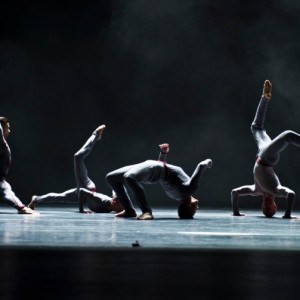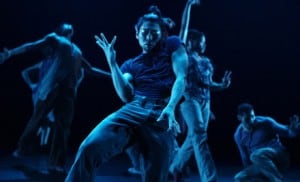Cedar Lake – Civic Theatre Auckland Arts Festival 2015
A lone dancer walks across the barren stage, lit only by a single row of fluorescent lights. His figure contorts in movements reminiscent of man’s primal origins- basic, hunched and grounded. Silence is his music, confronting the audience with pure movement and the screaming of emotions through his body alone.
This opening dance from the Cedar Lake Contemporary Ballet Company’s first piece at the Auckland Civic Theatre nailed them as an innovative, abstract and supremely talented company of dancers and choreographers. The skill and complexity of the choreography were matched by the athleticism and technical precision of the dancers.
The opening number was “Grace Engine”- by Canadian choreographer Crystal Pite. The pared- -back simplicity underlined the paradox of a collective loneliness, where light and shade were explored as if to express the layers of darkness to which the human soul is capable of succumbing . I had a visceral reaction to the underlying subtleties of this dance, where the movements shaped the dancers’ bodies into silhouettes of running men and women. They were running from something, but I wondered from what? From themselves? Perhaps.
Music with discernible beats was replaced by ominous train sounds, adding to the impression that this was a comment on humanity at its loneliest. The train seemed to represent how close we can be to one another, while still remaining profoundly distant.
As dancers performed in either groups or a pas de deux , their bodies presented the complexity of the choreography with fluidity, as one, while their simple costumes of skin -coloured tops gave the sense of humans almost -naked. This lent a vulnerability with which I could empathize . Despite those dark undertones, it can be comforting to witness a piece of art which addresses a common angst of the human condition.
 That feeling of being imprisoned by societal expectation was expressed in the ensemble movements, where dancers moved in a prisoner -like formation, conveying to the audience a feeling that although they wished for respite, they were trapped in their routine.
That feeling of being imprisoned by societal expectation was expressed in the ensemble movements, where dancers moved in a prisoner -like formation, conveying to the audience a feeling that although they wished for respite, they were trapped in their routine.
The second piece “Violet Kid” showcased a different kind of repertoire. Choreographed by Hofesh Shechter from the UK, the dance drew on the choreographer’s Jewish/religious background, using movements from religious folk dance, and playing with the idea of man’s search for harmony within his complex existence.
The dance went through a number of sudden changes in both movement and tempo, broken up by blackouts. This created a sense of cinema, as if we were watching the jump cuts of a film. Through this, Scheter could manipulate time and space, going back and forward from particular dance phrases, as well as building the performance to a peak , then cutting it off abruptly. The juxtaposition of manic, desperate dances with calm simplicity not only allowed for the choreography to underline its subtle messages, but also gave the dancers a forum for showcasing their staggering versatility.
While the lighting of the first piece was sparse and bare, the second created a low-lit, dusty, tribal world, where aggressors and victims danced around each other, searching for meaning in spirituality or humanity. And when the dancers stopped in formation to face out to the audience, each one individually lit, it seemed a call to us to search also.
In stark contrast to the first two pieces, the last dance“Necessity Again” by Norwegian choreographer Jo Strømgren, presented as light- hearted in its deconstruction of human stories and relationships. Many loose pieces of paper covered the stage, physically representing those myriad stories. Dancers frequently threw them in the air to show simultaneously, their importance and their irrelevance.
 Playfulness permeated the choreography, creating a 1950’s world where the dancers enhanced the music with their own cries of joy. This meant that on the one hand, there was light-heartedness to this number, yet on the other, primal notions of death and sex were introduced as a challenge to this seemingly- impermeable happiness. A female dancer oozed sexuality and control, as three topless male dancers moved with , and around , her while she sat on a table – a scene that felt out of place in the happy-go-lucky world to which we had first been introduced . At another time, all the dancers took off their clothes to dance in underwear, as the piece nodded to a profound vulnerability and desperation, taking me by surprise just as I had begun to feel comfortable.
Playfulness permeated the choreography, creating a 1950’s world where the dancers enhanced the music with their own cries of joy. This meant that on the one hand, there was light-heartedness to this number, yet on the other, primal notions of death and sex were introduced as a challenge to this seemingly- impermeable happiness. A female dancer oozed sexuality and control, as three topless male dancers moved with , and around , her while she sat on a table – a scene that felt out of place in the happy-go-lucky world to which we had first been introduced . At another time, all the dancers took off their clothes to dance in underwear, as the piece nodded to a profound vulnerability and desperation, taking me by surprise just as I had begun to feel comfortable.
Strømgren’s choreography, albeit very different from that of the first two , was as thought-provoking as those earlier pieces. The contrast between overt happiness and raw vulnerability left me questioning on which side of that fine line I fell, and felt.
The Cedar Lake Contemporary Ballet Company at once thrilled, enlightened, challenged and exposed me. I applaud the courage of its choreographers, dancers and artistic director for presenting such varied and colourful pieces, and daring to call into question the comfort of its audience.
A stunning piece of artistic expression that profoundly moved me.
-Margie Cooney
- Meels – Vultures: 13th Floor New Song Of The Day - 11/01/2026
- Georgia Mink – First Bouquet: 13th Floor New Song Of The Day - 10/01/2026
- alayna – Animal: 13th Floor New Song Of The Day - 09/01/2026